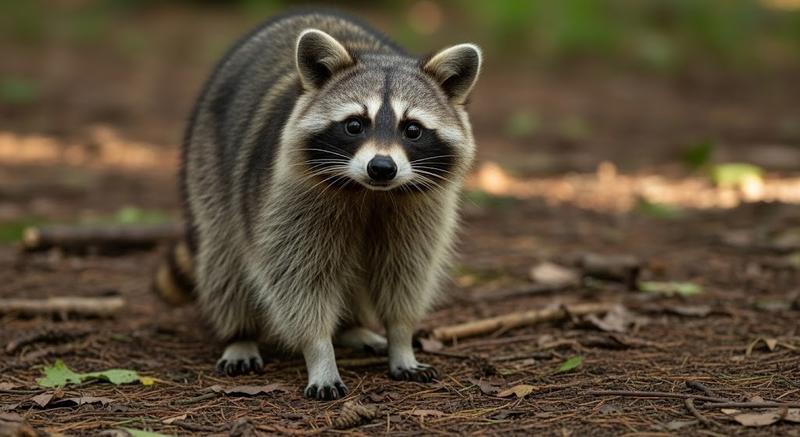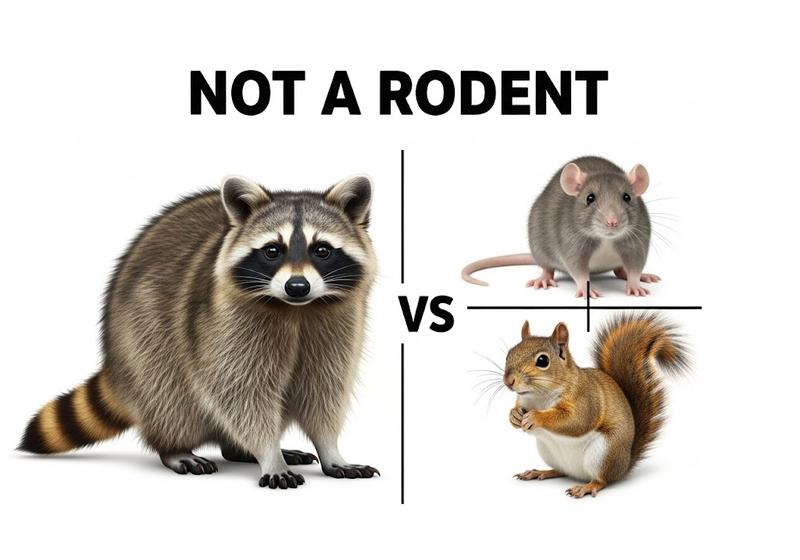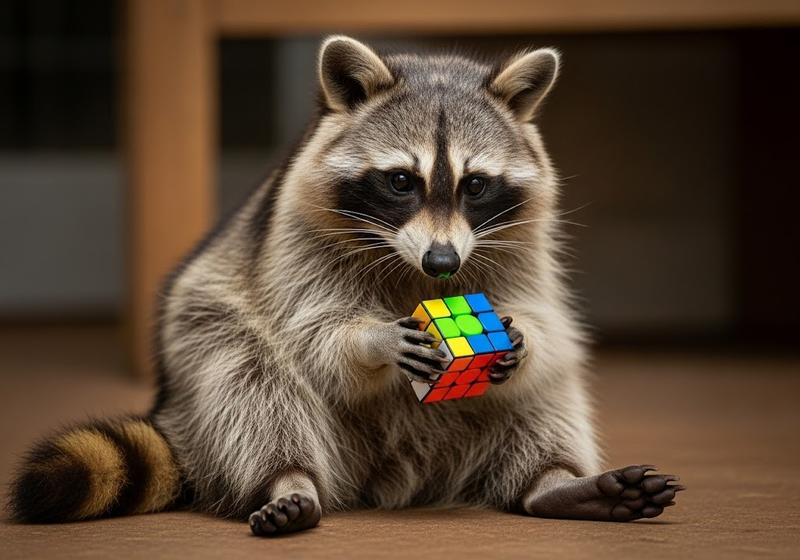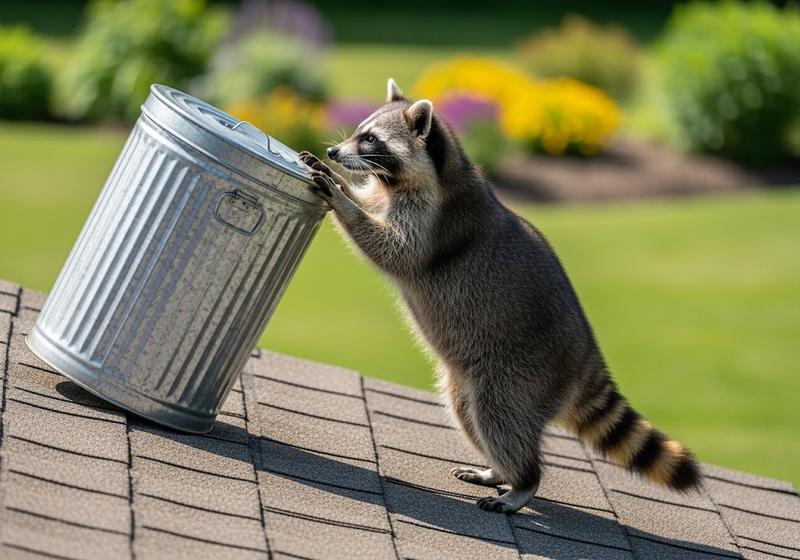Is a Raccoon a Rodent? The Truth About Their Classification

If you’ve ever caught a raccoon rifling through your trash at night, you might’ve wondered: Is that just a giant rat? The short answer: No, a raccoon is not a rodent. Despite their sneaky habits and urban mischief, raccoons belong to a completely different biological group.
Let’s break down why raccoons aren’t rodents, explore their actual classification, and clear up common myths about raccoon vs rodent behavior—with fun facts and science-backed explanations along the way.
So, is a raccoon a rodent?
Let’s start by answering the central question: No, raccoons are not rodents. While rodents belong to Rodentia, raccoons are classified under Carnivora and the family Procyonidae.
This means raccoons are in an entirely different evolutionary branch from rats, squirrels, and mice. Rodents are defined by specific traits—like constantly growing incisors and gnawing behavior—that raccoons don’t possess.
So if you’ve wondered, “Are raccoons in the rodent family?”, the answer is no. They’re their own type of mammal with closer relatives you might not expect.

What animal family is a raccoon in?
Now that we’ve clarified raccoons aren’t rodents, let’s see where they actually belong in the animal kingdom.
Raccoons are part of the Procyonidae family, which includes small-to-medium-sized mammals known for their cleverness, adaptability, and climbing ability. Here's the complete scientific breakdown of raccoon classification:
|
Rank |
Classification |
|
Kingdom |
Animalia |
|
Phylum |
Chordata |
|
Class |
Mammalia |
|
Order |
Carnivora |
|
Family |
Procyonidae |
|
Genus |
Procyon |
|
Species |
Procyon lotor |
This family shares traits with bears, red pandas, and coatis - not rodents. When looking at evolutionary history, raccoons fall much closer to carnivores than gnawing mammals like rats or beavers.
Why raccoons are not considered rodents
If raccoons aren’t in the rodent family, what exactly separates them?
This section explores the key biological and behavioral differences that clearly place raccoons in a different category than rodents.
Teeth and Skull Structure
Rodents have distinctive incisors that never stop growing. These teeth define their group and require constant gnawing to stay sharp. Raccoons, by contrast, have 40 teeth with canine-style fangs, built for tearing and crunching—not chewing through wires or wood.
Diet and Digestive System
Rodents are mostly herbivores, feeding on seeds, grains, and plants. Raccoons are omnivores, meaning they eat both plants and animals. Their flexible diet includes insects, fruit, eggs, small animals, and even human leftovers.
Intelligence and Dexterity
Raccoons are famous for their problem-solving ability. In studies, they’ve solved complex puzzles, remembered solutions for years, and even opened latches or jars. Rodents like rats and squirrels are intelligent too, but raccoons demonstrate more advanced spatial reasoning and manual dexterity.

Raccoons are known for their remarkable dexterity—sometimes even solving puzzles with their nimble paws.
Brain and Body Composition
The skull structure and brain-to-body ratio of raccoons also differ significantly from rodents. Their sensory abilities, motor skills, and memory reflect a higher level of adaptability typical of carnivorous mammals.
These traits confirm that raccoons are biologically and behaviorally distinct from rodents, despite occasional surface-level similarities.
What animals are raccoons related to?
So, if raccoons aren’t rodents, who are their closest relatives?
Let’s look at the family tree. Raccoons are most closely related to:
-
Coatis – long-snouted climbers from Central and South America
-
Kinkajous – nocturnal rainforest mammals with prehensile tails
-
Ringtails – agile desert dwellers in the southwestern U.S.
-
Red pandas – once considered part of the raccoon family, now in their own group but still evolutionarily close.
-
Bears – distant relatives through the shared Carnivora order
This group of animals is better adapted to tree life, omnivorous feeding, and flexible behavior—far removed from the grain-nibbling habits of rodents.
In other words, raccoons may look like overgrown rodents at a glance, but their biology places them squarely with other intelligent, adaptable wildlife species.
Common misconceptions: Are raccoons like rats or squirrels?
It’s easy to confuse raccoons with rodents like squirrels and rats, especially in urban environments. But when you compare them closely, the differences stand out.
Here’s a clear look at raccoon vs rodent behavior:
|
Trait |
Raccoon |
Rodents (e.g., rats, squirrels) |
|
Teeth |
Carnivore-style with canines |
Ever-growing incisors |
|
Feeding behavior |
Omnivorous, opportunistic |
Mostly herbivorous |
|
Paws/hands |
Highly dexterous “hands” |
Basic paws, limited manipulation |
|
Intelligence |
High, long-term memory |
Moderate problem-solving skills |
|
Social behavior |
Solitary or small family units |
Large colonies (rats) or seasonal groups |
|
Damage style |
Ripping or tearing |
Gnawing or chewing |
This is why so many pest control guides now differentiate wildlife pests vs rodents. While both can be a nuisance, the behavior, risk, and management strategies differ entirely.
Do raccoons cause rodent-like damage?
While raccoons aren’t rodents, they can cause problems in different ways.
Unlike rats or squirrels, which chew through wires and wood, raccoons rely on strength and dexterity to gain access. They don’t chew—they rip, pry, and claw.
Here's a side-by-side comparison:
|
Damage Type |
Raccoons |
Rodents |
|
Entry Behavior |
Rip off vents or shingles |
Gnaw holes through walls or wiring |
|
Trash Access |
Tip over cans, lift lids |
Chew through plastic bags or bins |
|
Roof or Attic Access |
Pry open roof tiles, soffits |
Squeeze through small gaps |
|
Indoor Damage |
Tear insulation, nesting |
Chew wires, leave droppings |
Because raccoons are considered wildlife in many regions, removing them often requires a professional licensed in animal control—not just a rodent trap. Some states even protect raccoons under wildlife regulations, adding another layer to their management.

Raccoons don’t gnaw like rodents—they pry, tip, and claw into food sources such as trash cans.
FAQs - Is a Raccoon a Rodent?
Is a raccoon a mammal or marsupial?
A raccoon is a placental mammal. That means it nourishes its young in the womb through a placenta—just like humans, dogs, and bears. Like kangaroos or opossums, Marsupials carry their young in pouches after birth.
Are raccoons dangerous like rats?
Raccoons can carry diseases like rabies, but they’re not prone to infestation like rats or mice. They live alone or in small family groups, don’t reproduce as rapidly, and rarely invade in large numbers.
Can I keep a raccoon as a pet?
In most places, no. Raccoons are considered wild animals and are often illegal to keep as pets without a special permit. Even where allowed, they require advanced care and can become aggressive or destructive as they mature.
What we now know about raccoons and rodents
To sum up:
-
Raccoons are not rodents—they belong to the Procyonidae family in the Carnivora order.
-
They’re more closely related to bears and red pandas than rats or squirrels.
Their teeth, behavior, and intelligence separate them from rodent characteristics entirely. -
While both raccoons and rodents can be pests, they fall under different categories: wildlife pests vs rodents.
Understanding raccoon classification helps us manage them more effectively and respect their wild nature.
Next time you spot a raccoon at night, remember—it’s not a giant rat. It’s a clever, adaptable mammal with a fascinating place in the animal world.
Now that you know the truth behind their classification, you can appreciate these masked mammals for what they truly are. Celebrate their unique identity and show off your expert knowledge with our collection of funny animal shirts or embrace the full aesthetic with our Raccoon Aesthetic Outfit ideas.
Recent Posts
- How Long Can Raccoons Survive Without Food or Water?
- How Long Do Raccoons Live? Wild vs Captive Lifespans Explained
- Are Raccoons Marsupials? Here's the Truth Behind the Confusion
- Are Raccoons Related to Bears? The Evolutionary Truth Explained
- 15 Animals That Look Like Raccoons and What Makes Them So Similar
- What Are Raccoons Good For? 4 Surprising Benefits You Should Know
- What’s a Group of Raccoons Called? Fun Facts & Rare Terms
- 20 Fun Facts About Raccoons That'll Surprise You
- Return Policy for Clothing Online: What You Need to Know
- How to Check the Quality of a T-Shirt Before Buying (2025 Guide)

